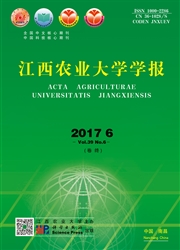

 中文摘要:
中文摘要:
为进一步了解和掌握樟树的蒸腾耗水机制,以期有效利用水资源,采用热扩散SF-L植物液流传感器测量得到的时间尺度为30 min的液流数据,结合同期相关气象因子的数值,分析了试验地区樟树的液流变化规律及其与气象要素的相关性。结果表明:(1)樟树液流具有明显的时间变化规律。单位边材面积上的日液流量大小在7、8月份最高,9月份开始呈下降趋势,次年1月份最小,之后又逐渐增大。液流速率月平均日变化均为单峰趋势,夜间液流速率很小,随着时间增加逐渐增大,午后达到最大值,且最大值出现在7月份,之后逐渐递减,1月份最小,3、4月份又逐渐回升;晴天条件下表现为单峰趋势,阴雨天表现为多峰趋势或无规则变化。(2)樟树的液流速率在白天与水汽压亏缺、太阳辐射和气温呈现显著正相关关系,与相对湿度呈现负相关关系,而与降水量无明显相关性,夜间樟树的液流速率与太阳辐射无明显相关性,与其它因子的正负相关性与白天相同;各相关系数在白天高于夜间,生长季高于非生长季。
 英文摘要:
英文摘要:
In order to understand and master the mechanism of evaportranspiration of camphor trees aiming at making better use of water, the rule of sap flow in camphor tree was analyzed through the experimental data,which were measured by thermal dissipation sap flow sensor, SF-L sensor in every 30 minutes, combined with the corresponding meteorological factors in the analysis of the rule of the correlations between camphor tree sap flow and meteorological factors was carried out. The results showed that: ( 1 ) the sap flow in camphor tree changed timely.The diurnal gross sap flow per unit sapwood in July and August was the highest, then there was a decrease trend since September and it reached its minimum in January, and then rose again till April.It demonstrated a single-peak curve in sunny days and a multimodal distribution or irregular change in overcast and rainy days.The monthly-average diurnal variations reached the highest in July and the lowest in January and went up in March and April. (2)The sap flow velocity of camphor tree in the daytime had a significantly positive correlation with VPD, solar radiation and temperature, and a negative correlation with related humidity while there was no significant correlation with precipitation. At night, the sap flow velocity of camphor tree showed no significant correlation with solar radiation, wheras the correlation with the other factorswas the same as in the daytime.The correlation coefficients turned out to be higher in the daytime than at night, and higher in the growing seasons than in the non-growing seasons.
 同期刊论文项目
同期刊论文项目
 同项目期刊论文
同项目期刊论文
 期刊信息
期刊信息
